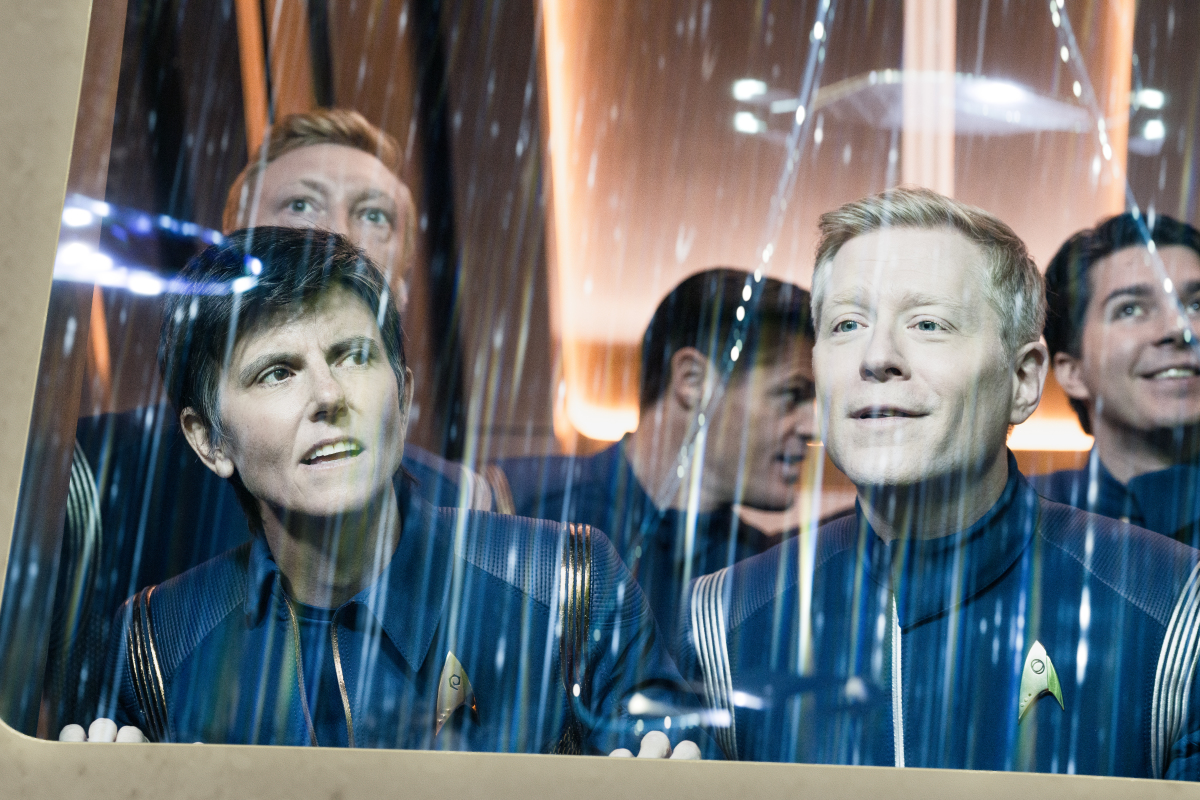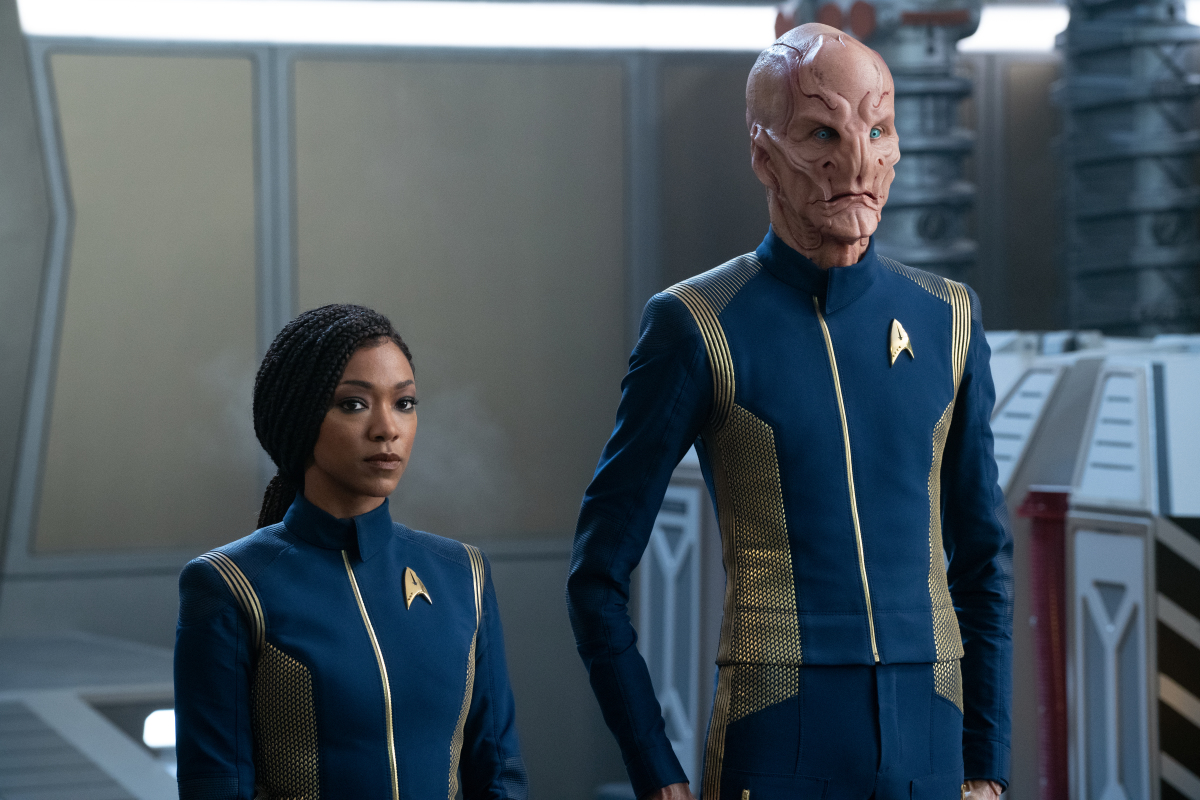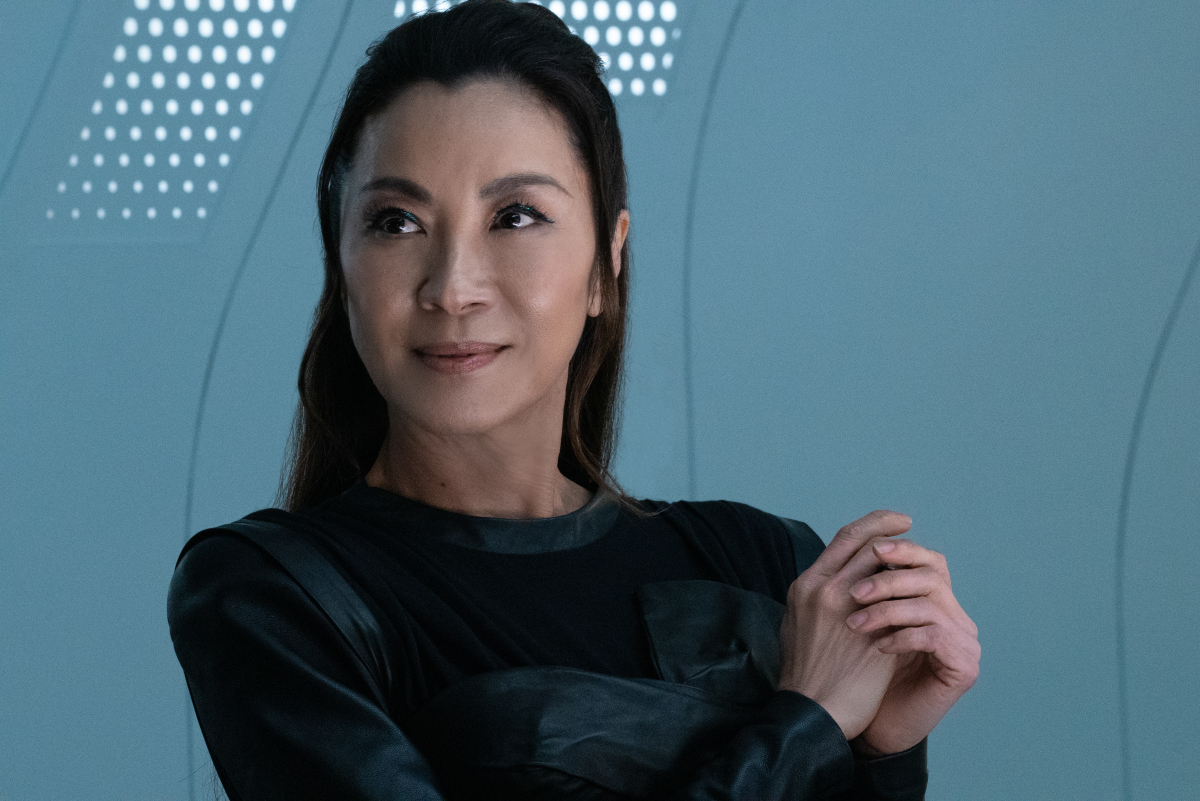So Earth might not have been home home for the tired, buckling crew of the USS Discovery. Trill might not have given all the answers, besides a reckoning of just what a number nearly a millennia of time travel will do on people. But now, our heroes have found the Federation — and Discovery has found that, even in all this newness, it can still pull a few old, clunky tricks.

“Die Trying” opens with an awfully quick, awfully heady sugar rush: so quickly after Adira, now fully one with the Tal symbiont, gives Burnham the co-ordinates to the Federation and Starfleet’s new home base, we’re wooshed away to a shimmering, secretive enclave of Federation vessels. They’ve come together across an interconnected, almost vine-like array of cables to create a massive cloaking field, at the heart of which sits the proverbial Yggdrasil: home, and all that’s left of the Starfleet and Federation our heroes have been longing for since this season began.
The glee on the bridge crew and general crew’s faces alike as they spot new kinds of old ships, familiar names, and welcome sights, is clear. Well, beyond the fact that the Starfleet nerds immediately geek out at the new tech they can see, from programmable matter to detachable nacelles. It’s clear that there is, in this joy, also relief: they know what they’re looking at. After weeks of rebuke, of reminders that they have all come so far and lost so much along the way, these are sights and sounds that they, as Starfleet officers, can recognise.

But just as with most things in the 32nd century, home has changed. This is not the Federation our heroes left behind, and very quickly, that familiarity is brushed up against a threatening unknown. That idea of the familiar and the unfamiliar clashing together sits throughout this episode — from the moment Saru, Michael, and Adira receive a frosty reception from Admiral Vance (Oded Fehr), the relief of stability is forced to reckon with the reality of the dire situation the Federation continues to be in.
It turns out that prior to Discovery’s arrival, the Federation enacted temporal laws that forbade time travel — a neat reference to the morass of timey-wimey complexity that showed up in Star Trek: Enterprise’s encounters with the Temporal Cold War. In turn, it places the time-travel that provided Discovery’s path to the 32nd century in a light of scepticism with Vance and Starfleet at large. Having previously unfathomable FTL travel technology and a Mirror Universe citizen among the crew doesn’t help either. But perhaps more crucially is that Vance’s scepticism of the Discovery’s arrival is that…they seem too good to be true.
They’re scions of the idealised past of Starfleet: the days of Kirk, before Kirk even Kirked. They all, clearly, even when confronted with hostility, earnestly believe in Starfleet’s noblest of ideals. They’re driven by the same passions and joys, whether it’s new starship tech or the simple, emotional reaction crewmembers like Saru and Nhan feel about learning their peoples went on to join the Federation. They have technology that would help this embattled Federation reach out to help those far beyond their current reach, blinking to aid in an instant.
However, it’s as clear on Vance’s face as his distrust: this Federation, this Starfleet, is tired. They so much want the Federation to be what it once was, but don’t have the resources to do it, and that is deeply frustrating to good people who just want to do good. They want to prove that there is still hope in the universe if species come together as one again. When the Discovery appears out of nowhere as the chance to do that? It’s almost too dangerous for these people to hope.

That, likewise, brushes up with Michael’s mindset. Spotting a group of aliens in Starfleet HQ’s sickbay being debilitated by a disease doctors can’t figure out, she sees both an opportunity to ingratiate the Discovery and her crew to Vance, but also somewhere that she, as the person she is, must reach out and help. But just as the Burn changed Starfleet, the 32nd century has changed Michael Burnham. Her desire to help is matched by her renewed realisation at how the restraints of protocol are now so frustrating to her — she’s pushing against Vance (much to Saru’s dismay) and she’s pushing against Saru too, who is unwilling to rock the boat with this suddenly new boss. But Michael pushes, realising that the Discovery can find a cure for the disease by using its spore drive to access a seed vault being maintained beyond Starfleet’s current effective reach.
Leaving behind the dramatic intrigue of the culture clash between the Starfleet crews of the 23rd and 32nd century, what follows is a pretty classic Trek caper. After being reluctantly given the chance to prove themselves by Vance, the Discovery crew heads to the vault ship to find two surprises, one personal and one more in the familiar vein of classic Star Trek story premises. The personal surprise is for Commander Nhan (the Enterprise expatriate who stayed with Discovery as security chief instead of returning with Pike), who learns that the vault is currently being maintained by a family of Barzan scientists — and that she, the first Barzan in Starfleet, is now joined by her entire planet as official Federation members.
The second is more unfortunate: a mysterious accident has plagued the research vessel and the Barzans who can unlock the vault aboard are nowhere to be found. As Michael, Nhan, and Doctor Culber beam over to investigate, we get something that feels both intimately familiar and yet alien for Discovery. We haven’t really had this kind of classic “crew beams over to an abandoned ghost ship” kind of set up since the Glenn in early season one. It’s like, in a brief moment of all this newness in the 32nd century, getting a little jolt of classic, old school Star Trek. They’re splitting off to scan things! They’re trying to access ship logs! They’re…being attacked by weird phasing holo-ghosts?
It’s that bit of familiarity that leads to another…and a frankly much less welcome one. It turns out that the seed-ship was hit by a Coronal Mass Ejection, dousing it with radiation that sadly killed all but one of the Barzans aboard — despite their bodies being put into cryostasis. The CME also knocked the mid-transporting father of the family, chief scientist Dr. Attis, out of phase, leading to him “haunting” the ship as he attempts in his grief to find a cure to save his lost family. After Nhan and Burnham manage to stabilise and ultimately convince Attis to let them help people who still have a chance with access to the seed vault, he relents — knowing that now that he is back in phase, he’s likely soon going to succumb to the same CME radiation that killed his family. And so, out of nowhere, Nhan decides that it is now up to her to look after the seed vault, leaving the Discovery behind in an impromptu, teary farewell.
Except…it isn’t. Well, it is. Nhan cries! Michael cries! Lotta crying! But, up until this episode, Nhan has been such a non-entity aboard the ship that this moment is absolutely not earned in the slightest. In fact, she evokes Airiam — the former Discovery cyborg bridge officer who perished on a mission with Nhan last season — in her exit, despite the fact Airiam’s death was an equally hamfisted moment of unearned emotion, for the same reasons. She was, essentially, a glorified extra until she got a bucketload of character background information in the episode she was killed off in. Nhan at least had more lines than Airiam ever did, but it’s the same thing that Discovery has tried to do before: plaster over faults with overwhelmingly dramatic emotional overtures that just don’t have the work put in them to hit as hard as they should.
[referenced id=”1152704″ url=”https://gizmodo.com.au/2019/03/star-trek-discoverys-season-2-episode-9/” thumb=”https://gizmodo.com.au/wp-content/uploads/2019/03/15/ytymzcdtqz4tqjvnqgfr.png” title=”Star Trek: Discovery’s War Against Section 31 Just Got A Whole Lot Messier And A Bit Less Interesting” excerpt=”Tonight’s Star Trek: Discovery made very clear what the major conflict of the rest of this season is going to be about. But in doing so, it seems to have sidestepped an altogether far more interesting conflict that’s already been brewing for most of the season.”]
“Die Trying” is reflective of some of Discovery’s biggest strengths and weaknesses since its very beginnings. The first half with the conflict between the Discovery crew and Vance’s Starfleet is fascinating and brilliant because it pits two halves of the same side against each other: good people trying to define the soul and willingness of the Federation’s ideals, in a period of crisis. We saw it with the Klingon War, we saw it with Section 31 and Control, and now we’re starting to see it in the internal conflict between Vance and Burnham. Yet that interesting drama is pushed aside for cheap emotional tricks that clumsily try to ride on an unearned climax, because up until basically this season, the show has struggled to spend time with its wider set of characters outside of those immediately in Burnham’s circle.
It’s clear now that this is the point at which Discovery’s third season is really reorienting itself. We’ve had the “build-up,” per se, of our heroes slowly but surely acclimatising to the new world in which they now live, the new world in which Discovery as a show has to inhabit. We’ve got the groundwork laid for a new normal, at least for now, and new mysteries for our heroes to chase. It’s perhaps not surprising then, that there are some bumps along the way as the show continues to show growing pains in this new scenario.
Some of them are good bumps, reflective of the ways Discovery has established that it and its characters need to work on, as it adapts to this new future. The rest? Well, we can only hope these are some last indulgences the show can work itself out of as we start to focus on the new.

Assorted Musings
- OK, forgive me for being geek-out-y as the crew was looking at all those new 32nd century Starfleet ships, but: AHHHHHHHH, THE VOYAGER-J!!!!! I love it. I love how that’s the ship they focused on to reveal the idea of generational refits. Also, I’m pretty sure one of the ships that flew by just after that was the U.S.S. Nog, which was a very sweet nod to the dearly missed Aron Eisenberg.
- Also fantastic: Those svelte new Starfleet uniforms. Nice badges (with holo-PADD stuff built-in!?), cool tones, the colour strip to define division. Welcome to the wardrobe, 32nd century. Glad you got over those weird tube-covered getups from the 31st.
- I’m sorry, it was cool enough Oded Fehr is in this episode, and then David Goddamn Cronenberg shows up to interrogate Georgiou? Amazing. I wonder if this was a one-off, but considering his seeming distance from the rest of the Starfleet we saw, and his interest in Georgiou, there’s a chance he could have a larger part to play…and maybe even a potential bridge to Georgiou’s spinoff show. He did seem low-key Section 31-y.
- Speaking of Georgiou: we learn that there’s basically been no Mirror Universe contact over 500 years, and that…something bad is up with Georgiou. She’s blanking out, clearly haunted by something. I wonder if that is more set up for what’s to come with her own adventures.
- Michael notes that the lullaby she heard Adira play at the end of the last episode comes up again in the holo-recordings of the Barzan family — and back at headquarters, she inquires to only discover that apparently some version of it is known across Federation member species and cultures. In an episode already littered with little setups for what could come, that too feels suspicious. A message, a key to something in a shared little cultural moment? That’d definitely be aligned with this season’s themes of shared communication and understanding.
